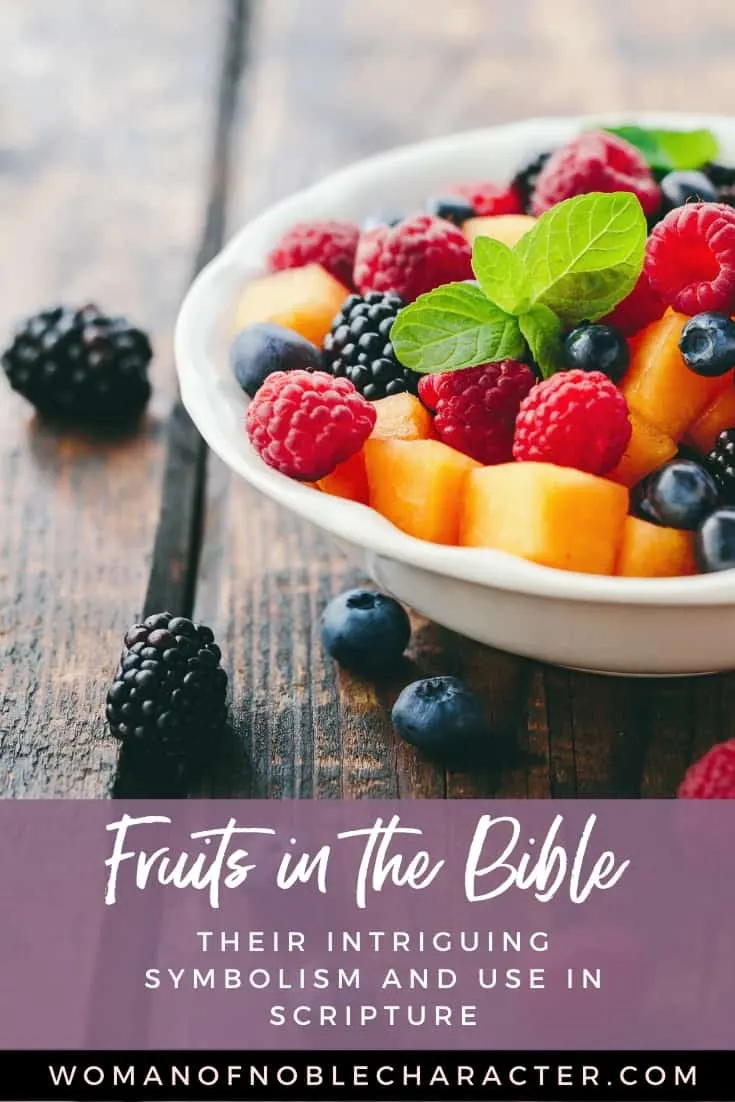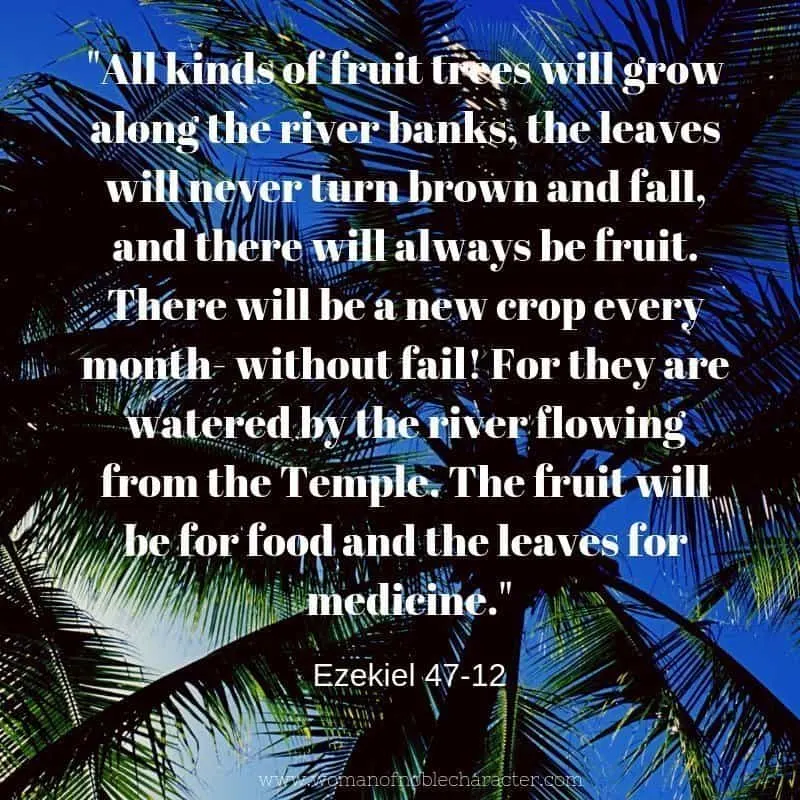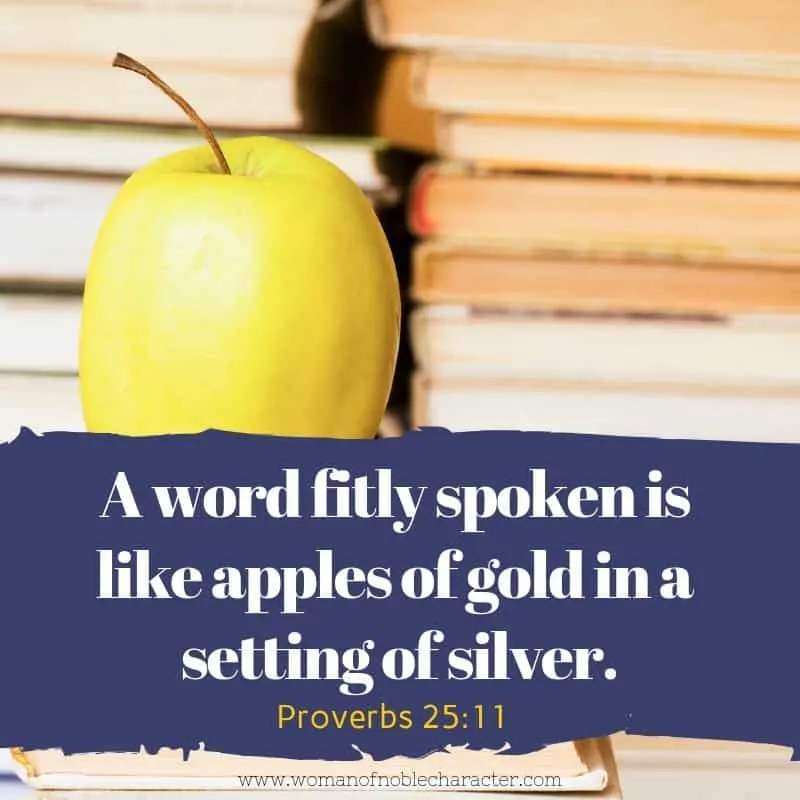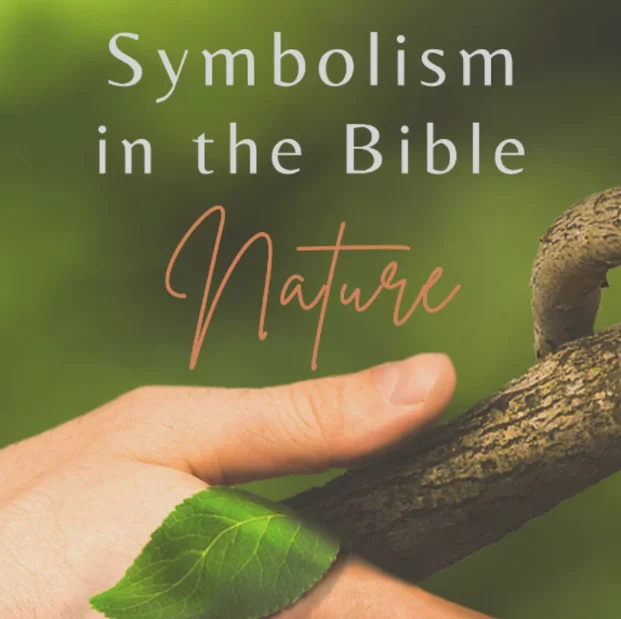This page/post may contain affiliate links. As an Amazon Associate, as well as an affiliate of other programs, this means if you purchase something using these links, I will receive a commission on qualifying purchases at no cost to you! For more detailed information, please visit our Affiliate Disclaimer page
Fruits in the Bible are rich with Bible symbolism and, as such, often make their way into my Bible journaling. In previous posts, I’ve written about Plants in the Bible, Open and Closed Doors in the Bible and even Birds in the Bible .
Let’s dive into the symbolism and uses of fruit in the Bible.
(If you are looking for more on how the fruit of the Spirit changes us, see this post)

First, however, let’s examine the word “fruit” in the Bible. The word fruit (as well as related words including fruits and fruitful) is found 66 times in the New Testament.
The Greek word most frequently used is καρπός (karpos). This word can be used literally or figuratively. Most often (41 times, in fact), it is used figuratively. Karpos (in the figurative way) , is defined as “the character of the “fruit” being evidence of the character of the power producing it”
In addition to how fruit is used in scripture, we find two main uses for fruit symbolism in the Bible:
The Fruit of Evangelism
In John 4:35-36, Jesus says, “Do you not say, ‘There are yet four months, then comes the harvest’? Look, I tell you, lift up your eyes, and see that the fields are white for harvest. Already the one who reaps is receiving wages and gathering fruit for eternal life, so that sower and reaper may rejoice together.” This shows us that the point of evangelism (or faithfulness to God’s kingdom work) is those converting to Christianity. “The one who reaps is receiving wages and gathering fruit for eternal life.” We don’t evangelize so that we feel good about ourselves. We evangelize so that people will enter new life and fellowship with Christ.
“Don’t you have a saying, ‘It’s still four months until harvest’? I tell you, open your eyes and look at the fields! They are ripe for harvest. Even now the one who reaps draws a wage and harvests a crop for eternal life, so that the sower and the reaper may be glad together.” – John 4:35-36
The Fruit of Salvation
In the gospel accounts, Matthew, Mark, and Luke tell the same parable of the sower. Each time, the respective authors quote Jesus saying, “As for what was sown on good soil, this is the one who hears the word and understands it. He indeed bears fruit and yields, in one case a hundredfold, in another sixty, and in another thirty” (Matthew 13:23; Mark 4:20; Luke 8:14-15).
“But the seed falling on good soil refers to someone who hears the word and understands it. This is the one who produces a crop, yielding a hundred, sixty or thirty times what was sown.” – Matthew 13:23
How Fruit in the Bible is Used in Scripture
From research and reading, I find that the fruit in the Bible is used in eight different ways in the Bible.
-
Fruits are Used as People’s Names
Many people are named after fruit, e.g., Tamar in Genesis 38:6, which means “date,” Tappuah in 1 Chronicles 2:43, which means “apple,” and Rimmon in 2 Samuel 4:2, which means “pomegranate.”
2) Fruits as Names of Places
Many towns and cities are named for fruits , e.g., Anab in Joshua 11:21, which means “grape,” Rimmon (pomegranate) in Joshua 15:32 and Tappuah (apple) in Joshua 12:17.
3) Fruits Are Used as Decorations or Adornments
Fruits and images of fruit are used as decorations, e.g., the blue, purple, and crimson pomegranates on Aaron’s priestly garments (Exodus 28:33-34) and the engraved date palm trees in Solomon’s Temple (1 Kings 6:29).
4) Fruits are Included in Many Biblical Laws
Fruits are the subjects of laws, e.g., the law in Numbers 6:3 that a Nazirite may not eat or drink grape products or the law in Deuteronomy 24:20 that one may only beat an olive tree
5) Fruits are Used in Metaphors and Similes
Fruits are used in a number of metaphors and similes such as, “Your breath is like the fragrance of apples” in Song of Songs 7:9 and “I found Israel [as pleasing] as grapes in the wilderness” in Hosea 9:10.
Grab your free fruit of the Spirit print-ables below!
6) Fruits Are Found in Blessings and Curses
Fruits appear in curses and blessings such as “Your olives shall drop off [the tree]” in Deuteronomy 28:40 and “[Israel is a blessed] land of wheat and barley, of vines, figs and pomegranates, a land of olive trees and honey” in Deuteronomy 8:8.
7) Fruits Are Used in Many Proverbs
Fruits are used to teach in many proverbs such as “He who tends to a fig tree will enjoy its fruit” in Proverbs 27:18 and “Parents eat sour grapes and their children’s teeth are blunted” in Ezekiel 18:2.
8) Literally in Narratives
Fruits appear as objects in narratives, such as in Numbers 13:23, where the spies of Moses examine the grapes, pomegranates and figs of the land, and in Genesis 3, where Eve eats the forbidden fruit and is cast from Eden.
In nearly all instances of fruit in the bible, the references fall under one of these uses. Fruit in the Bible was much more than a food for the ancient Israelites. It was a symbol that appeared prominently in the culture’s names, laws, proverbs and traditions.
NOTE: For each fruit mentioned, I have a free printable for you of Bible verses pertaining to that fruit. Use them in your war binder, your Bible journaling or your own study time in the Word.
Symbolism of Fruit in the Bible
As you know, fruit plays an important role in the Bible. If Eve had not taken the apple in Genesis 3, the story of Eden would have looked drastically different. Let’s take a look at the ways the Israelites used fruit in their writings and everyday culture.
The Hebrew Bible mentions six types of tree fruit, many of which appear dozens of times:
1. Grape (גפן)
No plant is mentioned more times in the Bible than the grape and its products, (such as wine, raisins and vinegar. The grape vine is grown solely for its fruit; there is no other use for the vine in the Scriptures. Even the wood of the vine is worthless (Ezekiel 15).
Pruning is essential for a vine to produce grapes. This is referred to in several Scriptures including Isaiah 5:6 and John 15:2. It is interesting to note that the Greek word for prune and cleanse is the same.
(kathairó καθαίρω)
Vineyards in the Bible are often referred to as being hedged. A hedge of protection is important when the vines are flowering. The flowers of the grape are greenish and inconspicuous. But they are very fragrant. It is likely that the “blossoming vine” mentioned in Song of Solomon 2 is the grape. It is at the flowering stage that the grape is especially vulnerable to damage. If the flowers don’t develop, there will be no fruit.
2. Fig (תאנה)
Mentioned over fifty times in the Bible, the flower of the tree is never seen, as its many tiny flowers are housed within the fruit bud. Two crops are produced each year. The first crop is eaten fresh, while the second crop is dried for winter.
The fig tree was extremely important for both nutritional and economic reasons in biblical times. When things were going well in Israel and the people prosperous, the Bible describes “every man sitting under his own fig tree” (1 Kings 4:25). The prophets, on the other hand, when predicting judgment on Israel, speak of the fig trees being destroyed (Jeremiah 5:17).
The first mention of any fruit tree, by name, in Scripture references the leaves of the fig tree, not the fruit. Adam and Eve sewed fig leaves together to hide their nakedness (Genesis 3:7).
3. Olive (זית)
There are about 25 references to the olive tree and more than 160 references to the oil. Olive oil had four main uses in Bible days: as food, for illumination, as an ointment, and in the manufacture of soap. It is probably safe to assume that when oil is mentioned in the Scriptures, it is always olive oil. Interestingly, we have no record in the Scriptures of olives themselves being eaten, although, that doesn’t necessarily mean that they were not a food item.
Olives are very attractive trees, as indicated in Hosea 14:6 and Psalm 128:3. In the dry season, the olive tree, with its green leaves, contrasts with the dry, brown hills. Leaves are evergreen, dark blue-green above and gray beneath. With a slight breeze, the trees will appear silverish, and in the dry season, the wind makes the hillsides glisten.
The first reference to the olive is to the leaf (Genesis 8:11). By seeing the leaf, Noah knew that he could now establish a race in the “new earth.”
In addition to routine use in homes, olive oil was used in the lamps in the tabernacle (Leviticus 24:2). It was also used as a facial ointment (Psalm 104:15), necessary in an arid land.
In biblical accounts, extending an olive branch meant the ending of hostilities between two parties and signaled the end of the conflict. After the flood of Noah’s day, he first sent out a raven (Genesis 8:6-7) but then Noah “sent forth a dove from him, to see if the waters had subsided from the face of the ground. But the dove found no place to set her foot, and she returned to him to the ark, for the waters were still on the face of the whole earth. So he put out his hand and took her and brought her into the ark with him” (Gen 8:8-9).
After another seven days, “again he sent forth the dove out of the ark. And the dove came back to him in the evening, and behold, in her mouth was a freshly plucked olive leaf. So Noah knew that the waters had subsided from the earth” (Genesis 8:10-11). That was a sign of peace…God would later promise never to send another flood to destroy man and all the other creatures.
4. Pomegranate (רמון)
Biblically, pomegranates crop up again and again in the scriptures. First of all, God himself prescribes that pomegranates must be sown to the hem of the robe of the high priest in Exodus 28:33 – 35:
“On its hem you shall make pomegranates of blue and purple and scarlet yarns, around its hem, with bells of gold between them, a golden bell and a pomegranate, a golden bell and a pomegranate, around the hem of the robe. And it shall be on Aaron when he ministers, and its sound shall be heard when he goes into the Holy Place before the Lord, and when he comes out, so that he does not die.”
The English word “pomegranate” originated from a compound Latin word that meant apple with grains i.e. pomum meant apple and granatum meant grain. In the Holy Scriptures, the Hebrew word for pomegranate is pronounced rim-mone.
Pomegranates were among the natural abundance specified by the LORD in the promised land i.e. a “land of wheat, and barley, and vines, and fig trees, and pomegranates.”

Pomegranates, grapes, and figs were brought back by the scouts when the Israelites were given their first opportunity to enter the promised land.
By the time of the Exodus, the Israelites were already familiar with pomegranates, from which the LORD had provided them to live in Egypt. Unfortunately, they never stopped their whining and complaining along the way while on the journey through the Sinai; long enough to realize that where the LORD was leading them was far better than the place that they had left.
Jewish tradition teaches that the pomegranate is a symbol of righteousness because it is said to have 613 seeds, which corresponds with the 613 mitzvot, or commandments, of the Torah. For this reason and others, it is customary to eat pomegranates on Rosh Hashanah. Moreover, the pomegranate represents fruitfulness, knowledge, learning, and wisdom.
Interestingly, many Jewish scholars believe that the pomegranate was the “forbidden fruit” of the Garden of Eden. Furthermore, the pomegranate is listed in the Bible as one of the seven species (shivat haminim) of fruits and grains that are special products of the Land of Israel.
5. Date (תמר)
The date palm might just be the oldest fruit-bearing tree on our planet. It was certainly essential for our biblical ancestors, who made use of it in every part of the tree – not just the fruits. The fronds (leaves) were woven into baskets, mats, brooms, and ropes, the trunks of the trees were used to build structures, the sap was fermented into wine, and the fruit, of course, was eaten for sustenance.
Peace, Victory, and Fertility
In the Bible, the palm tree is a symbol of peace, victory, and also of fertility. The image of the palm tree was imprinted on Roman and Greek coins of the day, and the dates themselves were a valuable commodity, providing a resource that was traded as far as Africa and the Middle East. It is thought that the Greeks carved their columns to represent the trunks of the date palm.
In Ezekiel 47:12, the Old Testament tells of the trees that grow along the sandy river banks, whose leaves will never turn brown or fall. The fruit would provide food and the leaves medicine for the Israelites as they made their new home in Canaan on the banks of the Jordan River. This was the fabled ‘promised land,’ also known as the ‘land of milk and honey.’
Jericho, along the Mediterranean coast, was referred to as the ‘City of Palms.’ This region was also the land of the Canaanites and the Philistines, located where Lebanon and Beirut stand today. The region was also known for its olives, grapes, figs, and pomegranates.
A Symbol of Beauty
The palm tree was seen as beauty personified, and in Genesis, it was referred to as Tamar, a term also used to describe a beautiful woman.
There are many references in the bible directing people to use the date palm to build a shelter or nourish their bodies. The image of palm trees figured prominently in Temple art of the day, described often in Ezekiel 41: “the walls were decorated with cherubim, each with two faces and alternating with palm trees.”
Do You Love Nature? Do You Find Bible Symbolism Fascinating?
209 pages of nature symbolism in the Bible! Dive into what the Bible says about many different things in nature from animals to water and from clay to rainbows. Read about and study the fascinating symbolism of God’s creation and learn more about His character.
6. Apple (תפוח)
The word “apple” appears 8 times in the King James Version and 7 times in other English translations (NKJV, NIV, NRSV).
“Apple” was used as the translation of 4 different Hebrew words:
תַּפּ֫וּחַ —transliterations: tappuah (tappuaḦ) or tappuach or tappuwach
‘iyshown
babah
bath

Beth-tappuah means “place of apples” (a town in Judah). Tappuah was the name of 3 other ancient biblical places—a town in Judah (formerly a royal city of the Canaanites).
Biblical scholars have long argued about what fruit תַּפּ֫וּחַ refers to. Most believe it is the apple, but others suggest the apricot or quince, or orange. There is no clear evidence that apples grew in Israel (most likely due to the heat). But they were certainly not unknown in Israel, and the land does have cooler hill country. They definitely grew north of Israel in Lebanon. The ancient Romans cultivated apple trees extensively. It is possible that climatic conditions may have been more favorable in ancient times in Israel.
What is your favorite verse about fruit in the Bible?
If you’d like to learn easy ways to draw fruit in your Bible journaling, see this post.
Looking for more on fruit of the Spirit? See this post.
Because of Him,
Sue

